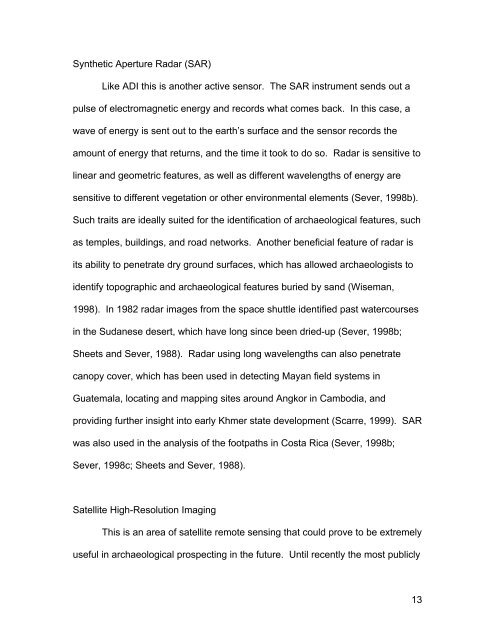A Review of Remote Sensing Application in Archaeological Research
A Review of Remote Sensing Application in Archaeological Research
A Review of Remote Sensing Application in Archaeological Research
You also want an ePaper? Increase the reach of your titles
YUMPU automatically turns print PDFs into web optimized ePapers that Google loves.
Synthetic Aperture Radar (SAR)<br />
Like ADI this is another active sensor. The SAR <strong>in</strong>strument sends out a<br />
pulse <strong>of</strong> electromagnetic energy and records what comes back. In this case, a<br />
wave <strong>of</strong> energy is sent out to the earth’s surface and the sensor records the<br />
amount <strong>of</strong> energy that returns, and the time it took to do so. Radar is sensitive to<br />
l<strong>in</strong>ear and geometric features, as well as different wavelengths <strong>of</strong> energy are<br />
sensitive to different vegetation or other environmental elements (Sever, 1998b).<br />
Such traits are ideally suited for the identification <strong>of</strong> archaeological features, such<br />
as temples, build<strong>in</strong>gs, and road networks. Another beneficial feature <strong>of</strong> radar is<br />
its ability to penetrate dry ground surfaces, which has allowed archaeologists to<br />
identify topographic and archaeological features buried by sand (Wiseman,<br />
1998). In 1982 radar images from the space shuttle identified past watercourses<br />
<strong>in</strong> the Sudanese desert, which have long s<strong>in</strong>ce been dried-up (Sever, 1998b;<br />
Sheets and Sever, 1988). Radar us<strong>in</strong>g long wavelengths can also penetrate<br />
canopy cover, which has been used <strong>in</strong> detect<strong>in</strong>g Mayan field systems <strong>in</strong><br />
Guatemala, locat<strong>in</strong>g and mapp<strong>in</strong>g sites around Angkor <strong>in</strong> Cambodia, and<br />
provid<strong>in</strong>g further <strong>in</strong>sight <strong>in</strong>to early Khmer state development (Scarre, 1999). SAR<br />
was also used <strong>in</strong> the analysis <strong>of</strong> the footpaths <strong>in</strong> Costa Rica (Sever, 1998b;<br />
Sever, 1998c; Sheets and Sever, 1988).<br />
Satellite High-Resolution Imag<strong>in</strong>g<br />
This is an area <strong>of</strong> satellite remote sens<strong>in</strong>g that could prove to be extremely<br />
useful <strong>in</strong> archaeological prospect<strong>in</strong>g <strong>in</strong> the future. Until recently the most publicly<br />
13
















